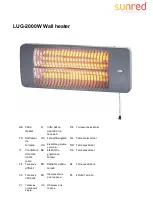
33
Servicing should only be performed by a Qualified Service Agent
table 3
blower prover
blocked intake air
Blocked Exhaust
†Activation Pressure
+0.75" W.C.
-2.00" W.C.
+2.00" W.C.
Tolerance
± 0.05" W.C.
± 0.05" W.C.
± 0.05" W.C.
†Though it is uncommon, pressure switch specifications can be changed by the manufacturer. These activation pressures are
current as of the (month/year - expressed as MM/yy) date code printed on the front cover of this manual in the lower left corner.
If the accuracy of these specifications are in doubt call the toll free support phone number on the back cover of this manual to
verify.
Pressure Test:
1. Ensure power to the water heater is turned off at the water heater's on/off switch.
2. Disconnect the sensing tube from the switch being tested.
3. Connect a digital manometer to the sensing tube disconnected above or connect a longer manometer
sensing tube to the port on the water heater if needed, see figure 32 on page 30 and figure 34 on page 34.
4. Restore power to the water heater, if the water heater does not begin a heating cycle raise the Operating
Set Point to activate a heating cycle.
5. When the Combustion Blower comes on and ramps up to full speed, record the pressure reading.
6. Repeat this test for all three pressure switches as necessary.
7. Compare the pressure readings taken to the activation pressures in Table 3 above.
8. Ensure all sensing tubes are properly routed and reconnected when testing is complete, see Sensing
Tubes on page 30.
Results/Actions
blower prover:
If the pressure reading taken at the Blower Prover switch sensing tube is at or above the
activation pressure shown in Table 3
and
the switch contacts did not close during the Continuity Test During
Operation on page 32 - the switch is defective and must be replaced. If the pressure reading taken does not
reach or rise above the activation pressure in Table 3 the pressure switch
is not
defective and should not
be replaced - call the toll free phone number on the back cover of this manual for further technical assistance.
Have the complete Model, Series and Serial number (located on the water heater's rating label) for the water
heater being serviced on hand before calling.
blocked intake air:
Note these are negative pressures; in a vacuum. If the pressure reading taken at the
Blocked Intake Air switch sensing tube does not reach or drop lower than the pressure shown in Table 3
and
the switch contacts were opening during the Continuity Test During Operation on page 32 - the switch
is defective and must be replaced. If the pressure reading taken reaches or drops lower than the pressure
shown in Table 3 and the switch contacts were opening during the Continuity Test During Operation on page
32 - the switch
is not
defective and should not be replaced. Check for restrictions at the intake air connection
on the water heater, check for too small of pipe installed, too many equivalent feet and/or too many elbows in
the intake air piping. Check for low points in the intake air piping where water may be collecting and blocking
the intake air piping. Check for any restrictions or debris at the intake air termination outdoors. Check for
condensate/water in the sensing tube/switch, if the sensing tube has water in it, replace the Blocked Intake
Air switch and the tube. Ensure the sensing port is oriented properly, see Intake Air Connection on page 5.
Blocked Exhaust:
If the pressure reading taken at the Blocked Exhaust switch sensing tube does not reach
or rise above the activation pressure given in Table 3
and
the switch contacts were opening during the
Continuity Test During Operation on page 32 - the switch is defective and must be replaced. If the pressure
reading taken reaches or exceeds the pressure shown in Table 3 and the switch contacts were opening
during the Continuity Test During Operation on page 32 - the switch
is not
defective and should not be
replaced. Ensure the condensate drain connected to the exhaust elbow on the water heater is not clogged
and is draining freely. Check for restrictions or blockage in the vent pipe, check for too small of pipe installed,
too many equivalent feet and/or too many elbows in the vent piping. Check for low points in the vent pipe
where water may be collecting and blocking the vent piping. Check for any restrictions or debris at the vent
termination outdoors.
















































